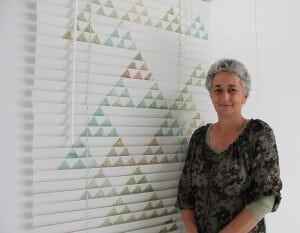Contemporary Māori artist Raewyn Paterson is to expand her creative horizons by studying for unique postgraduate degrees being offered next year by EIT.
The two programmes will be New Zealand’s only applied honours and master’s creative practice degrees steeped in kaupapa Māori philosophy.
Of Tuhoe descent, Raewyn will study Te Hono ki Toi (Poutiri-a-rangi) – Bachelor of Professional Creative Practice (Honours) and then progress to Te Hono ki Toi (Poutiriao) – Master of Professional Creative Practice.
While the programmes are designed for both Pākehā and Māori, they are particularly attractive to Māori because their delivery will be within a Māori learning context.
Flexible in their design, they can be tailored to the individual student’s creative direction – whether that’s a Māori, Eurocentric or any other cultural form of self-expression.
“I’ve always wanted to do my master’s,” says Raewyn, who completed EIT’s Bachelor of Visual Arts and Design in 2010.
It also suits that both degrees will be practice-based and that they can be studied locally. Both programmes will be jointly delivered by EIT Hawke’s Bay’s ideaschool and EIT Tairāwhiti’s Toihoukura, giving students access to two schools of lecturers and artists.
Up until now, graduates have had to leave the regions to undertake postgraduate study in the arts.
Raewyn is planning a part-time approach to study so she can continue in her various roles at ideaschool. “I have to eat,” she jokes.
Since graduating, the Napier-based artist has worked part-time, teaching on EIT’s visual arts and design programme, mentoring Māori students across ideaschool and coordinating events. A committed learner, she has also completed EIT’s Certificate in Tertiary Learning and Teaching and the levels 2 and 4 Certificate in Māori programmes.
Raewyn also continues to evolve her creative practice. Last year, her contemporary take on tukutuku panels featured in a major collaborative exhibition with Emanuel Dunn, who showcased his cardboard constructions portraying the Māori creation story.
The exhibition occupied the foyer of the Hastings City Art Gallery.
Raewyn and friends are currently organising an exhibition which will be held at the Hastings Community Arts Centre as part of the celebrations centred on Waitangi Day.
“The kaupapa is around whakawhanaugatanga, building relationships and networking with other Māori artists in Hawke’s Bay.”
For her master’s studies, Raewyn has been considering eco-design solutions, community art and design projects and ways of identifying through Māori patterns.
“I am questioning who my art and designs are for, what benefits they might have for a community, which skills and research would benefit my own hapῡ and what it is that I want to learn more about.
“Pathways have magically opened up for me since I more fully focused on art,” she points out. “Continuing with study is the next obvious pathway for my future.”


